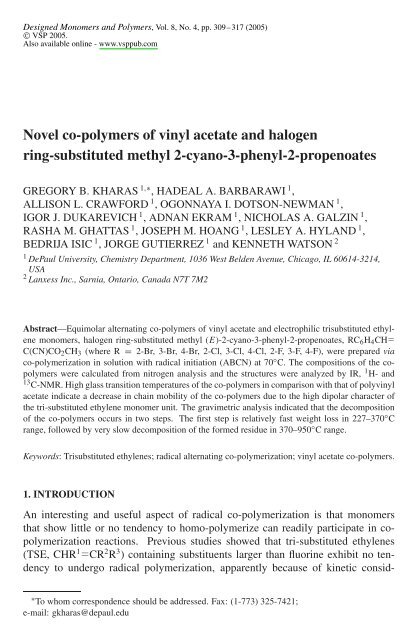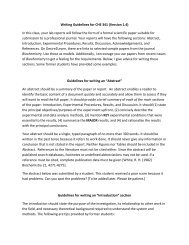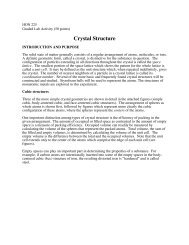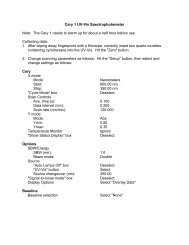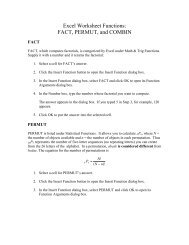Novel co-polymers of vinyl acetate and halogen ... - IngentaConnect
Novel co-polymers of vinyl acetate and halogen ... - IngentaConnect
Novel co-polymers of vinyl acetate and halogen ... - IngentaConnect
You also want an ePaper? Increase the reach of your titles
YUMPU automatically turns print PDFs into web optimized ePapers that Google loves.
Designed Monomers <strong>and</strong> Polymers, Vol. 8, No. 4, pp. 309–317 (2005)<br />
© VSP 2005.<br />
Also available online - www.vsppub.<strong>co</strong>m<br />
<strong>Novel</strong> <strong>co</strong>-<strong>polymers</strong> <strong>of</strong> <strong>vinyl</strong> <strong>acetate</strong> <strong>and</strong> <strong>halogen</strong><br />
ring-substituted methyl 2-cyano-3-phenyl-2-propenoates<br />
GREGORY B. KHARAS 1,∗ , HADEAL A. BARBARAWI 1 ,<br />
ALLISON L. CRAWFORD 1 , OGONNAYA I. DOTSON-NEWMAN 1 ,<br />
IGOR J. DUKAREVICH 1 , ADNAN EKRAM 1 , NICHOLAS A. GALZIN 1 ,<br />
RASHA M. GHATTAS 1 , JOSEPH M. HOANG 1 , LESLEY A. HYLAND 1 ,<br />
BEDRIJA ISIC 1 , JORGE GUTIERREZ 1 <strong>and</strong> KENNETH WATSON 2<br />
1 DePaul University, Chemistry Department, 1036 West Belden Avenue, Chicago, IL 60614-3214,<br />
USA<br />
2 Lanxess Inc., Sarnia, Ontario, Canada N7T 7M2<br />
Abstract—Equimolar alternating <strong>co</strong>-<strong>polymers</strong> <strong>of</strong> <strong>vinyl</strong> <strong>acetate</strong> <strong>and</strong> electrophilic trisubstituted ethylene<br />
monomers, <strong>halogen</strong> ring-substituted methyl (E)-2-cyano-3-phenyl-2-propenoates, RC 6 H 4 CH<br />
C(CN)CO 2 CH 3 (where R = 2-Br, 3-Br, 4-Br, 2-Cl, 3-Cl, 4-Cl, 2-F, 3-F, 4-F), were prepared via<br />
<strong>co</strong>-polymerization in solution with radical initiation (ABCN) at 70 ◦ C. The <strong>co</strong>mpositions <strong>of</strong> the <strong>co</strong><strong>polymers</strong><br />
were calculated from nitrogen analysis <strong>and</strong> the structures were analyzed by IR, 1 H- <strong>and</strong><br />
13 C-NMR. High glass transition temperatures <strong>of</strong> the <strong>co</strong>-<strong>polymers</strong> in <strong>co</strong>mparison with that <strong>of</strong> poly<strong>vinyl</strong><br />
<strong>acetate</strong> indicate a decrease in chain mobility <strong>of</strong> the <strong>co</strong>-<strong>polymers</strong> due to the high dipolar character <strong>of</strong><br />
the tri-substituted ethylene monomer unit. The gravimetric analysis indicated that the de<strong>co</strong>mposition<br />
<strong>of</strong> the <strong>co</strong>-<strong>polymers</strong> occurs in two steps. The first step is relatively fast weight loss in 227–370 ◦ C<br />
range, followed by very slow de<strong>co</strong>mposition <strong>of</strong> the formed residue in 370–950 ◦ C range.<br />
Keywords: Trisubstituted ethylenes; radical alternating <strong>co</strong>-polymerization; <strong>vinyl</strong> <strong>acetate</strong> <strong>co</strong>-<strong>polymers</strong>.<br />
1. INTRODUCTION<br />
An interesting <strong>and</strong> useful aspect <strong>of</strong> radical <strong>co</strong>-polymerization is that monomers<br />
that show little or no tendency to homo-polymerize can readily participate in <strong>co</strong>polymerization<br />
reactions. Previous studies showed that tri-substituted ethylenes<br />
(TSE, CHR 1 CR 2 R 3 ) <strong>co</strong>ntaining substituents larger than fluorine exhibit no tendency<br />
to undergo radical polymerization, apparently because <strong>of</strong> kinetic <strong>co</strong>nsid-<br />
∗ To whom <strong>co</strong>rrespondence should be addressed. Fax: (1-773) 325-7421;<br />
e-mail: gkharas@depaul.edu
310 G. B. Kharas et al.<br />
erations superimposed on the thermodynamic factor responsible for the difficulty<br />
with which 1,1- <strong>and</strong> 1,2-di-substituted ethylenes polymerize [1]. Radical <strong>co</strong>polymerization<br />
provides the most general method <strong>of</strong> over<strong>co</strong>ming problems en<strong>co</strong>untered<br />
in homo-polymerization <strong>of</strong> TSE monomers. This approach has been particularly<br />
successful in preparing <strong>co</strong>-<strong>polymers</strong> from electrophilic TSE monomers having<br />
double bonds substituted with halo, cyano <strong>and</strong> carbonyl groups <strong>and</strong> electron-rich<br />
mono-substituted monomers like styrene [2, 3], N-<strong>vinyl</strong> carbazole [3] <strong>and</strong> <strong>vinyl</strong><br />
<strong>acetate</strong> [4].<br />
In <strong>co</strong>ntinuation <strong>of</strong> our studies <strong>of</strong> the monomer structure–reactivity <strong>co</strong>rrelations<br />
in the radical <strong>co</strong>-polymerization <strong>of</strong> TSE monomers [5–7] it was <strong>of</strong> interest<br />
to explore the feasibility <strong>of</strong> <strong>co</strong>-polymerization <strong>of</strong> <strong>halogen</strong> ring-substituted<br />
methyl (E)-2-cyano-3-phenyl-2-propenoates, RC 6 H 4 CH C(CN)CO 2 CH 3 ,where<br />
R = 2-Br, 3-Br, 4-Br, 2-Cl, 3-Cl, 4-Cl, 2-F, 3-F, 4-F, with <strong>vinyl</strong> <strong>acetate</strong> (VAC).<br />
2. MATERIALS AND METHODS<br />
2.1. General procedures<br />
Infrared spectra <strong>of</strong> the VAC-TSE <strong>co</strong>-<strong>polymers</strong> (KBr pellets) were determined with<br />
a Ni<strong>co</strong>let Avatar 360 FT-IR spectrometer. The glass transition temperatures (T g )<strong>of</strong><br />
the <strong>polymers</strong> were measured with a TA (Thermal Analysis) Model 2010 differential<br />
scanning calorimeter (DSC). The thermal scans were performed from ambient<br />
to 200 ◦ C range at a heating rate <strong>of</strong> 10 ◦ C/min. T g was taken as a midpoint <strong>of</strong> a straight<br />
line between the inflection <strong>of</strong> the peak’s onset <strong>and</strong> end-point. The thermal stability<br />
<strong>of</strong> the <strong>co</strong>-<strong>polymers</strong> was measured by a thermogravimetric analyzer TA Model 2090<br />
from ambient temperature to 600 ◦ Cat20 ◦ C/min. The molecular weights <strong>of</strong> the<br />
<strong>polymers</strong> were determined relative to polystyrene st<strong>and</strong>ards in CHCl 3 solutions with<br />
sample <strong>co</strong>ncentrations <strong>of</strong> 0.8% (w/v) by gel-permeation chromatography (GPC)<br />
using a Waters Model 510 pump at an elution rate <strong>of</strong> 1.0 ml/min; Styragel (Waters)<br />
<strong>co</strong>lumns in series: 10 6 ,10 5 ,10 4 ,10 3 <strong>and</strong> 500 Å at 25 ◦ C, a Model 410 refractive<br />
index <strong>and</strong> Vis<strong>co</strong>tek T50A differential vis<strong>co</strong>meter detectors.<br />
1 H- <strong>and</strong> 13 C-NMR spectra were obtained on 10% polymer solutions in CDCl 3<br />
at ambient temperature using a Bruker WP270SY spectrometer operating at<br />
200.13 MHz for 1 H-NMR <strong>and</strong> 50.33 MHz for 13 C-NMR. Relaxation times were at<br />
least 5-times the longest T 1 value in each spectrum. The distortionless enhancement<br />
by polarization transfer (DEPT) NMR spectra were obtained with evolution delay<br />
<strong>of</strong> 3.704 ms to produce negative methylene <strong>and</strong> positive methine <strong>and</strong> methyl 13 C<br />
resonance signals. 1 H– 13 C <strong>co</strong>rrelation spectra were run using the st<strong>and</strong>ard XHCOR<br />
Bruker program.<br />
Elemental analyses were performed by Quantitative Technologies.
2.2. Synthesis <strong>of</strong> the TSE monomers<br />
<strong>Novel</strong> VAC-TSE <strong>co</strong>-<strong>polymers</strong> 311<br />
TSE monomers were synthesized by Knoevenagel <strong>co</strong>ndensation [8] <strong>of</strong> a ringsubstituted<br />
benzaldehyde with an active hydrogen <strong>co</strong>mpound, methyl cyano<strong>acetate</strong>,<br />
catalyzed by a base, piperidine:<br />
RC 6 H 4 CHO + NCCH 2 CO 2 CH 3 → RC 6 H 4 CH C(CN)CO 2 CH 3 (1)<br />
2-Bromobenzaldehyde, 3-bromobenzaldehyde, 4-bromobenzaldehyde, 2-chlorobenzaldehyde,<br />
3-chlorobenzaldehyde, 4-chlorobenzaldehyde, 2-fluorobenzaldehyde,<br />
3-fluorobenzaldehyde, 4-fluorobenzaldehyde, methyl cyano<strong>acetate</strong>, DMF <strong>and</strong><br />
piperidine, supplied by Aldrich, were used for monomer synthesis as received. The<br />
preparation procedure <strong>and</strong> characterization <strong>of</strong> the TSE monomers was described<br />
earlier [9, 10]. The <strong>co</strong>ndensation reaction proceeded smoothly, yielding crystalline<br />
products, which were purified by <strong>co</strong>nventional techniques.<br />
2.3. Co-polymerization<br />
Vinyl <strong>acetate</strong> (VAC, Aldrich) was distilled at 72 ◦ C before use. Ethyl <strong>acetate</strong><br />
(Aldrich) was used as received. 1,1 ′ -Azobis(cyclohexanecarbonitrile) (ABCN)<br />
(Aldrich) was recrystallized twice from ethyl al<strong>co</strong>hol <strong>and</strong> then dried under reduced<br />
pressure at room temperature. Co-<strong>polymers</strong> <strong>of</strong> the TSE monomers <strong>and</strong> <strong>vinyl</strong> <strong>acetate</strong><br />
were prepared in 25-ml Pyrex screw cap ampoules at VAC/TSE = 2:1 molar<br />
ratio <strong>of</strong> the monomer feed using 0.12 mol/l <strong>of</strong> ABCN at an overall monomer<br />
<strong>co</strong>ncentration 2.44 mol/l in 10 ml <strong>of</strong> ethyl <strong>acetate</strong>. The <strong>co</strong>-polymerization was<br />
<strong>co</strong>nducted at 70 ◦ C. After a predetermined time, the mixture was <strong>co</strong>oled to room<br />
temperature, <strong>and</strong> precipitated drop-wise in petroleum ether. The crude <strong>co</strong>-<strong>polymers</strong><br />
were purified by re-precipitation from chlor<strong>of</strong>orm solution into an excess <strong>of</strong><br />
petroleum ether. The <strong>co</strong>mposition <strong>of</strong> the <strong>co</strong>-<strong>polymers</strong> was determined based on<br />
the nitrogen <strong>co</strong>ntent.<br />
3. RESULTS AND DISCUSSION<br />
3.1. Homo-polymerization<br />
An attempted homo-polymerization <strong>of</strong> the TSE monomers in the presence <strong>of</strong> ABCN<br />
did not produce any polymer as indicated by the lack <strong>of</strong> a precipitate in petroleum<br />
ether. The inability <strong>of</strong> the monomers to polymerize is associated with steric<br />
difficulties en<strong>co</strong>untered in the homo-polymerization <strong>of</strong> 1,1- <strong>and</strong> 1,2-di-substituted<br />
ethylenes [11]. This type <strong>of</strong> steric hindrance would increase the activation energy<br />
required for addition <strong>and</strong> slow down the rate <strong>of</strong> propagation to such an extent as<br />
to favor the occurrence <strong>of</strong> a chain transfer or termination instead. The homopolymerization<br />
<strong>of</strong> VAC under <strong>co</strong>nditions identical to those in the <strong>co</strong>-polymerization<br />
experiments yielded 26.8% <strong>of</strong> poly<strong>vinyl</strong> <strong>acetate</strong>, when polymerized for 30 min.
312 G. B. Kharas et al.<br />
3.2. Co-polymerization<br />
Co-polymerization (Scheme 1) <strong>of</strong> VAC <strong>and</strong> the <strong>halogen</strong> ring-substituted methyl<br />
(E)-2-cyano-3-phenyl-2-propenoates resulted in the formation <strong>of</strong> <strong>co</strong>-<strong>polymers</strong> (Table<br />
1) with weight-average molecular masses <strong>of</strong> 12.3 to 20.2 kDa.<br />
In an attempt to qualitatively <strong>co</strong>rrelate the observed monomer reactivities, we<br />
<strong>co</strong>nsidered <strong>co</strong>-polymer <strong>co</strong>mposition data obtained at VAC/TSE = 2 monomer feed.<br />
The relative reactivity <strong>of</strong> VAC in <strong>co</strong>-polymerization with these monomers can be<br />
estimated by assuming applicability <strong>of</strong> the <strong>co</strong>-polymer <strong>co</strong>mposition (equation (2))<br />
<strong>of</strong> the terminal <strong>co</strong>-polymerization model [11]:<br />
m 1 /m 2 =[M 1 ](r 1 [M 1 ]+[M 2 ])/[M 2 ]([M 1 ]+r 2 [M 2 ]) (2)<br />
m 1 <strong>and</strong> m 2 are the mol fractions <strong>of</strong> VAC <strong>and</strong> TSE monomer units in the <strong>co</strong>polymer,<br />
respectively; [M 1 ] <strong>and</strong> [M 2 ] are the <strong>co</strong>ncentrations <strong>of</strong> VAC <strong>and</strong> a TSE<br />
in the monomer feed, respectively; r 1 = k 11 /k 12 <strong>and</strong> r 2 = k 22 /k 21 .<br />
In the absence <strong>of</strong> the self-propagation <strong>of</strong> TSE monomers (k 22 = 0, r 2 = 0), <strong>and</strong> at<br />
monomer feed [M 1 ]/[M 2 ]=2, equation (2) yields:<br />
r 1 = 0.5(m 1 /(m 2 − 1)) (3)<br />
Scheme 1. VAC-TSE <strong>co</strong>-polymer synthesis. R = 2-, 3- <strong>and</strong> 4-Br, Cl <strong>and</strong> F.<br />
Table 1.<br />
Co-polymerization <strong>of</strong> <strong>vinyl</strong> <strong>acetate</strong> (M 1 ) <strong>and</strong> <strong>halogen</strong> ring-substituted methyl 2-cyano-3-phenyl-2-<br />
propenoates, RC 6 H 4 CH C(CN)CO 2 CH 3 (M 2 )<br />
R Yield a Nitrogen m 2 in <strong>co</strong>- Molecular T b g TGA ( ◦ C) Residue (%)<br />
(M 2 ) (wt%) (wt%) polymer mass ( ◦ C) Onset <strong>of</strong> 10% wt 50% wt<br />
(mol%) (kDa) de<strong>co</strong>mp. loss loss<br />
2-Br 35.0 4.04 49.2 13.3 110 240 251 358 15.7<br />
3-Br 51.9 4.03 49.8 13.1 117 227 238 353 13.7<br />
4-Br 60.7 4.03 49.6 14.6 133 232 283 370 17.9<br />
2-Cl 48.8 4.59 48.4 20.2 121 235 269 348 17.1<br />
3-Cl 55.7 4.56 49.2 12.7 126 233 279 353 14.8<br />
4-Cl 37.4 4.52 49.8 12.3 131 225 254 348 16.3<br />
2-F 21.9 4.81 50.0 16.7 101 227 252 345 19.7<br />
3-F 49.0 4.61 46.8 19.9 102 228 257 351 14.1<br />
4-F 60.8 4.77 49.7 14.3 110 232 261 335 10.5<br />
a Polymerization time was 8 h.<br />
b T g transition was observed by DSC.
<strong>Novel</strong> VAC-TSE <strong>co</strong>-<strong>polymers</strong> 313<br />
Consideration <strong>of</strong> the <strong>co</strong>-polymerization <strong>co</strong>nstants ac<strong>co</strong>rding to equation (3) also<br />
involves the assumption <strong>of</strong> minimal <strong>co</strong>-polymer <strong>co</strong>mpositional drift at this monomer<br />
feed <strong>and</strong> given <strong>co</strong>nversion. This non-rigorous kinetic treatment nevertheless allows<br />
estimation <strong>of</strong> the reactivity <strong>of</strong> a <strong>vinyl</strong> <strong>acetate</strong>-ended polymer radical in reaction with<br />
electrophilic monomer. Very low values <strong>of</strong> r 1 for 2-Br (0.02), 3-Br (0.00), 4-Br<br />
(0.01), 2-Cl (0.03), 3-Cl (0.02), 4-Cl (0.00), 2-F (0.00), 3-F (0.07) <strong>and</strong> 4-F (0.01)<br />
suggest that VAC <strong>and</strong> TSE enter into the <strong>co</strong>-polymer in equimolar amounts in a<br />
non-r<strong>and</strong>om, alternating arrangement along the <strong>co</strong>-polymer chain.<br />
3.3. Characterization<br />
3.3.1. IR spectra. The VAC-TSE <strong>co</strong>-<strong>polymers</strong> were characterized by FT-IR<br />
spectros<strong>co</strong>py. All the IR spectra <strong>of</strong> the <strong>co</strong>-<strong>polymers</strong> show overlapping b<strong>and</strong>s in the<br />
3300–2600 cm −1 region, <strong>co</strong>rresponding to C H vibrations. The absorptions <strong>of</strong> the<br />
VAC units appear at 1748–1751 cm −1 (carbonyl group), 1366–1374 cm −1 (wagging<br />
CH 3 ), 1221–1236 cm −1 (stretching COO), <strong>and</strong> 1010–1016 <strong>and</strong> 1095–1110 cm −1<br />
(stretching C C C). The b<strong>and</strong>s for the TSE monomer unit are 2237–2245 cm −1<br />
(w, CN), 1748–1751 cm −1 (s, C O) <strong>and</strong> 1221–1238 cm −1 (m, C O). A <strong>co</strong>mparison<br />
<strong>of</strong> the spectra <strong>of</strong> the <strong>co</strong>-<strong>polymers</strong> <strong>and</strong> poly<strong>vinyl</strong> <strong>acetate</strong> shows that the reaction<br />
between the TSE monomers <strong>and</strong> VAC is a <strong>co</strong>-polymerization.<br />
3.3.2. NMR spectra. A typical 1 H-NMR spectrum <strong>of</strong> a <strong>halogen</strong> substituted<br />
VAC-TSE <strong>co</strong>-polymer in CDCl 3 is shown in Fig. 1. The assignment <strong>of</strong> proton<br />
resonances for the <strong>co</strong>-<strong>polymers</strong> was carried out based on the spectra <strong>of</strong> model<br />
<strong>co</strong>mpounds, monomers <strong>and</strong> <strong>polymers</strong>, DEPT, 1 H– 13 C <strong>co</strong>rrelation spectra, as well<br />
as the results <strong>of</strong> the peaks’ areas integration. The integration data support the<br />
equimolar <strong>co</strong>mposition <strong>of</strong> the <strong>co</strong>-<strong>polymers</strong>. All spectra show a broad peak in the<br />
6.5–8.0 ppm region <strong>co</strong>rresponding to the phenyl ring protons <strong>of</strong> the TSE. A broad<br />
signal in the 4.7–5.7 ppm region is assigned to the VAC methine protons. The peaks<br />
in the range 3.5–4.2 ppm <strong>and</strong> 3.2–3.5 ppm are assigned to the methoxy <strong>and</strong> the<br />
methine protons <strong>of</strong> the TSE monomer unit, respectively. A signal in 1.7–2.7 ppm<br />
range <strong>co</strong>rresponds to VAC methyl group. Broad, overlapping resonances in the<br />
0.9–2.5 ppm region are assigned to the methylene proton <strong>of</strong> VAC monomer unit.<br />
Broadening <strong>of</strong> the NMR signals in the spectra <strong>of</strong> the <strong>co</strong>-<strong>polymers</strong> is apparently<br />
associated with head-to-tail <strong>and</strong> head-to-head structures, which formed through the<br />
attack <strong>of</strong> a VAC-ended radical on both sides <strong>of</strong> the TSE monomer unit. It was<br />
demonstrated that both head-to-tail <strong>and</strong> head-to-head structures TSE-styrene dyads<br />
exist in the <strong>co</strong>-<strong>polymers</strong> <strong>of</strong> styrene <strong>and</strong> 2-phenyl-1,1-dicyanoethene [12].<br />
The 13 C-NMR <strong>and</strong> DEPT spectra <strong>of</strong> the <strong>co</strong>-<strong>polymers</strong> also support the suggested<br />
skeletal structure <strong>of</strong> the <strong>co</strong>-<strong>polymers</strong>. Thus, in the typical spectrum <strong>of</strong> the VAC-TSE<br />
<strong>co</strong>-polymer in CDCl 3 (Fig. 2) the assignment <strong>of</strong> peaks is as follows: 167–175 ppm<br />
(C O), 120–140 ppm (phenyl carbons), 115–120 ppm (CN), 52–57 ppm (OCH 3<br />
<strong>and</strong> methine) <strong>and</strong> 46–52 ppm (quaternary carbon) <strong>of</strong> TSE unit. The peaks<br />
<strong>co</strong>rresponding to the carbons <strong>of</strong> VAC monomer unit are at 170 ppm (C O),
314 G. B. Kharas et al.<br />
Figure 1. 1 H-NMR spectrum <strong>of</strong> VAC-methyl 2-cyano-3-(4-bromophenyl)-2-propenoate <strong>co</strong>-polymer<br />
in CDCl 3 .<br />
65–72 ppm (methine), 35–47 ppm (CH 2 ) <strong>and</strong> 20–30 ppm (CH 3 ). The broad carbon<br />
resonances are most likely due to the presence <strong>of</strong> both H–T <strong>and</strong> H–H dyads. The<br />
NMR data showed that these are true <strong>co</strong>-<strong>polymers</strong>, <strong>co</strong>mposed <strong>of</strong> both VAC <strong>and</strong> TSE<br />
monomer units.<br />
3.4. Physical properties<br />
The <strong>co</strong>-<strong>polymers</strong> prepared in the present work are all soluble in methyl ethyl ketone,<br />
acetone, benzene, THF, DMF <strong>and</strong> CHCl 3 <strong>and</strong> insoluble hexane, cyclohexane, <strong>and</strong><br />
in ethyl <strong>and</strong> petroleum ether. They are amorphous <strong>and</strong> show no crystalline DSC<br />
endotherm. Figure 3 shows a typical DSC <strong>and</strong> TG analysis <strong>of</strong> the VAC-methyl<br />
2-cyano-3-(2-chlorophenyl)-2-propenoate <strong>co</strong>-polymer heated in nitrogen. High T g<br />
<strong>of</strong> the <strong>co</strong>-<strong>polymers</strong> (Table 1 <strong>and</strong> Fig. 3), in <strong>co</strong>mparison with that <strong>of</strong> poly<strong>vinyl</strong> <strong>acetate</strong><br />
(T g = 28–31 ◦ C) indicates a decrease in the chain mobility <strong>of</strong> the <strong>co</strong>-polymer<br />
due to the high dipolar character <strong>of</strong> the TSE structural unit. Information on the<br />
degradation <strong>of</strong> the <strong>co</strong>-<strong>polymers</strong> was obtained from thermogravimetric analysis. The<br />
TGA in nitrogen <strong>and</strong> air produce similar traces. The de<strong>co</strong>mposition <strong>of</strong> the <strong>co</strong><strong>polymers</strong><br />
occurs in two steps, presumably acetic acid elimination in the 227–370 ◦ C<br />
range followed by very slow de<strong>co</strong>mposition <strong>of</strong> the formed at about 400 ◦ C residue
<strong>Novel</strong> VAC-TSE <strong>co</strong>-<strong>polymers</strong> 315<br />
Figure 2. 13 C-NMR <strong>and</strong> DEPT spectrum <strong>of</strong> VAC-methyl 2-cyano-3-(4-bromophenyl)-2-propenoate<br />
<strong>co</strong>-polymer in CDCl 3 .<br />
(20–15%). Such a two-step degradation, acetic acid elimination followed by<br />
polyacetylene degradation, is known for poly<strong>vinyl</strong> <strong>acetate</strong> [13]. The <strong>co</strong>ntinued<br />
heating up to 950 ◦ C brings down the weight <strong>of</strong> the residue to about 10%. The<br />
de<strong>co</strong>mposition products were not analyzed in this study <strong>and</strong> the mechanism has yet<br />
to be investigated.<br />
4. CONCLUSIONS<br />
The <strong>co</strong>-polymerization <strong>of</strong> <strong>vinyl</strong> <strong>acetate</strong> <strong>and</strong> tri-substituted ethylenes, <strong>halogen</strong> ringsubstituted<br />
methyl 2-cyano-3-phenyl-2-propenoates, results in equimolar alternating<br />
<strong>co</strong>-<strong>polymers</strong>. The <strong>co</strong>mpositions <strong>of</strong> the <strong>co</strong>-<strong>polymers</strong> were calculated from nitrogen<br />
analysis <strong>and</strong> the structures were analyzed by IR, 1 H- <strong>and</strong> 13 C-NMR. High glass<br />
transition temperatures <strong>of</strong> the <strong>co</strong>-<strong>polymers</strong>, in <strong>co</strong>mparison with that <strong>of</strong> poly<strong>vinyl</strong> <strong>acetate</strong>,<br />
indicate a substantial decrease in the chain mobility <strong>of</strong> the <strong>co</strong>-<strong>polymers</strong> due to<br />
the high dipolar character <strong>of</strong> the tri-substituted ethylene monomer unit. The gravi-
316 G. B. Kharas et al.<br />
DSC <strong>and</strong> TGA traces <strong>of</strong> VAC-methyl 2-cyano-3-(2-chlorophenyl)-2-propenoate <strong>co</strong>-<br />
Figure 3.<br />
polymer.<br />
metric analysis indicated that the de<strong>co</strong>mposition <strong>of</strong> the <strong>co</strong>-<strong>polymers</strong> occurs in two<br />
steps. The first step is relatively fast weight loss in the 227–370 ◦ C range, followed<br />
by very slow de<strong>co</strong>mposition <strong>of</strong> the formed residue in the 370–950 ◦ C range.<br />
Acknowledgements<br />
We are grateful to acknowledge that the project was partly the Coatings Industry<br />
Education Fund (CIEF), the Chicago Society <strong>of</strong> Coating Technology, <strong>and</strong> the Office<br />
<strong>of</strong> Sponsored Programs <strong>and</strong> Research <strong>of</strong> DePaul University. J.G. was supported by<br />
a CIEF graduate fellowship.<br />
REFERENCES<br />
1. G. B. Kharas, in: Polymeric Materials Encyclopedia, J. C. Salamone (Ed.), Vol. 11, p. 8405.<br />
CRC Press, Boca Raton, FL (1996).<br />
2. M. Kriesel, U. Garbatsky <strong>and</strong> D. H. Kohn, J. Polym. Sci. Part A 2, 105 (1964).<br />
3. H. K. Hall Jr., Polym. Prepr. 37, 214 (1996).<br />
4. G. B. Kharas <strong>and</strong> D. H. Kohn, J. Polym. Sci. Polym. Chem. Edn. 21, 1453 (1983).<br />
5. G. B. Kharas, A. M. Fuerst, E. L. Feitl, M. E. Pepper, F. C. Prillaman, J. R. Pyo, G. M. Rogers,<br />
A. Z. Tadros, L. G. Umek <strong>and</strong> K. Watson, J. Macromol. Sci. Pure Appl. Chem. A41, 629 (2004).<br />
6. G. B. Kharas, K. E. Mc Colough, J. R. Heiskell, J. E. Herrman, J. A. Levun, E. M. Lucchetta,<br />
G. Villaseñor, L. A. Parish-Chafey, P. J. Schreiber, P. A. O’Malley, B. G. Starkman, G. Verdoorn,<br />
L. B. Passe <strong>and</strong> K. Watson, Designed Monomers Polymers 6, 103 (2003).
<strong>Novel</strong> VAC-TSE <strong>co</strong>-<strong>polymers</strong> 317<br />
7. G. B. Kharas, A. M. Fuerst, A. S<strong>co</strong>la III, D. J. Bavirsha, B. M. Bernau, S. K. Brown, P. Ece,<br />
A. N. Dabrowski, P. De Angelo, F. R. Fatemi <strong>and</strong> K. Watson, J. Macromol. Sci. Pure Appl. Chem.<br />
A30, 1383 (2002).<br />
8. R. L. Reeves, in: The Chemistry <strong>of</strong> the Carbonyl Bond, S. Patai (Ed.), Ch. 2. Interscience, New<br />
York, NY (1966).<br />
9. K. Kim, C. A. Butler, M. R. Cisneros, S. L. Ryan, M. A. Schwartz, N. A. Lindquist, G. B. Kharas<br />
<strong>and</strong> J. V. DeFrances<strong>co</strong>, Polym. Bull. 40, 361 (1998).<br />
10. G. B. Kharas, T. S. Wheeler, J. M. Eaker, S. A. Armatys, J. Fehringer, R. Gehant, E. Glaser,<br />
K. Johnson, P. Moy <strong>and</strong> G. R. Quinting, Macromol. Rep. A32, 405 (1995).<br />
11. G. Odian, Principles <strong>of</strong> Polymerization, 3rd edn. Wiley, New York, NY (1991).<br />
12. G. B. Kharas, P. A. Mirau, K. Watson <strong>and</strong> H. J. Harwood, Polym. Int. 28, 67 (1992).<br />
13. B. J. Holl<strong>and</strong> <strong>and</strong> J. N. Hay, Polymer 43, 2207 (2002).


